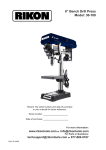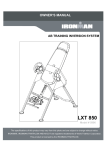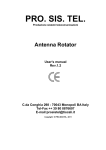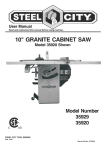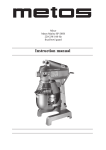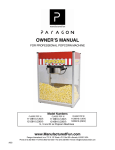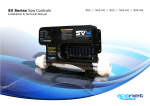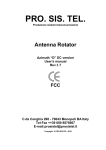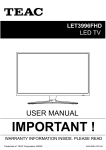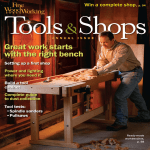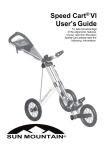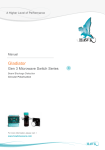Download Product Manual - RIKON Power Tools
Transcript
10” Left Tilt Contractor Saw 30” Rip Fence Owner’s Manual Model: 10-201 Record the serial number and date of purchase in your manual for future reference. Serial number: Date of purchase: 233282 For more information: www.rikontools.com or [email protected] For Parts or Questions: [email protected] or 877-884-5167 Part # 10-201M1 Safety Warning IMPORTANT! Safety is the single most important consideration in the operation of this equipment. The following instructions must be followed at all times. There are certain applications for which this tool was designed. We strongly recommend that this tool not be modified and/ or used for any other application other than that for which it was designed. If you have any questions about its application, do not use the tool until you have contacted us and we have advised you. General Safety Warnings KNOW YOUR POWER TOOL. Read the owner’s manual carefully. Learn the tool’s applications, work capabilities, and its specific potential hazards. ALWAYS GROUND ALL TOOLS. If your tool is equipped with a three-pronged plug, you must plug it into a three-hole electric receptacle. If you use an adapter to accommodate a two-pronged receptacle, you must attach the adapter plug to a known ground. Never remove the third prong of the plug. ALWAYS AVOID DANGEROUS ENVIRONMENTS. Never use power tools in damp or wet locations. Keep your work area well lighted and clear of clutter. ALWAYS REMOVE THE ADJUSTING KEYS AND WRENCHES FROM TOOLS AFTER USE. Form the habit of checking to see that keys and adjusting wrenches are removed from the tool before turning it on. ALWAYS KEEP YOUR WORK AREA CLEAN. Cluttered areas and benches invite accidents. ALWAYS KEEP VISITORS AWAY FROM RUNNING MACHINES. All visitors should be kept a safe distance from the work area. ALWAYS MAKE THE WORKSHOP CHILDPROOF. Childproof with padlocks, master switches, or by removing starter keys. NEVER OPERATE A TOOL WHILE UNDER THE INFLUENCE OF DRUGS, MEDICATION, OR ALCOHOL. ALWAYS WEAR PROPER APPAREL. Never wear loose clothing or jewelry that might get caught in moving parts. Rubber-soled footwear is recommended for the best footing. ALWAYS USE SAFETY GLASSES AND WEAR HEARING PROTECTION. Also use a face or dust mask if the cutting operation is dusty. NEVER OVERREACH. Keep your proper footing and balance at all times. NEVER STAND ON TOOLS. Serious injury could occur if the tool is tipped or if the cutting tool is accidentally 2 ALWAYS DISCONNECT TOOLS. Disconnect tools before servicing and when changing accessories such as blades, bits, and cutters. ALWAYS AVOID ACCIDENTAL STARTING. Make sure switch is in “OFF” position before plugging in cord. NEVER LEAVE TOOLS RUNNING UNATTENDED. ALWAYS CHECK FOR DAMAGED PARTS. Before initial or continual use of the tool, a guard or other part that is damaged should be checked to assure that it will operate properly and perform its intended function. Check for alignment of moving parts, binding of moving parts, breakage of parts, mounting, and any other conditions that may affect its operation. A guard or other damaged parts should immediately be properly repaired or replaced. Special Safety Rules For Table Saws 1. Always wear eye protection. 2. Keep hands away from the saw blade while machine is running. 3. Always use blade guard during normal cutting operations. 4. Always use splitter during normal cutting operations. 5. Use push sticks when ripping narrow stock. 6. Always use fence while ripping and miter gauge while cross-cutting. 7. Never reach over or behind saw blade while machine is running. 8. Do not remove cut-off or jammed pieces until blade has come to a full stop. 9. Disconnect machine from power source before making repairs or adjustments. 10. Do not expose saw or power cord to water or use in damp locations. California Proposition 65 Warning WARNING: Some dust created by power sanding, sawing, grinding, drilling, and other construction activities contains chemicals known to the State of California to cause cancer and birth defects or other reproductive harm.Your risk from exposure to these chemicals varies, depending on how often you do this type of work. To reduce your exposure, work in a well-ventilated area and with approved safety equipment, such as dust masks that are specially designed to filter out microscopic particles. For more detailed information about California Propostion 65 log onto rikontools.com. SAVE THESE INSTRUCTIONS. Refer to them often. 3 Table of Contents Safety Warnings......................................................................................................................................2-3 Table Saw Safety Rules....................................................................................................................... 3 Specifications.........................................................................................................................................................4 Unpacking and Contents..................................................................................................................................... .5 Getting to Know Your Table Saw..............................................................................................................6 Assembly..............................................................................................................................................................7 Adjustments ..................................................................................................................................................15 Operations ..............................................................................................................................................19 Maintenance ......................................................................................................................................................24 Electrical Requirements .......................................................................................................................25 Grounding Instructions .........................................................................................................................26 Parts Explosion & List .................................................................................................................................. 27 Warranty .............................................................................................................................................. 37 Specifications 10-201 1.5HP 13/6.5 120/240 60Hz 3450RPM Left 10” 5/8” 11-39/64”(W)x27”(D) 40”(W)x27”(D) 13-45/64”(W)x27”(D) 14-29/32”(W)x27”(D) 12/1/2” 30” 20” 3-3/8” Model Number Motor Induction Amps Volts/Hertz Motor/Blade Speed Blade Tilt Blade Diameter Blade Arbor Table Size w/o Wings Table Size with Wings Left Wing Dimension Right Wing Dimension Table Front of Blade Rip Capacity (Right) Rip Capacity (Left) Max Depth of Cut @ 90° 4 Contents of Package Unpacking and Checking Contents Unpack your 10-201 Contractor Saw from its carton and check to see that you have all of the following items. Do not turn your saw ON if any of these items are missing. You may cause injury to yourself or damage to your machine. If any parts are missing contact RIKON Technical Support at 1-877-884-5167 or [email protected]. A) Blade Guard and Splitter Assembly B) On/Off Switch C) Miter Gauge D) Blade Wrench E) Blade Wrench F) Handwheel Assembly(2) G) Handwheel Lock Knob(2) AA) M4x8mm ROUND HD TAP SCREW (2) AB) WRENCH HOOK AC) M8 HEX NUT (2) AD) M8 SPRING WASHER (2) AE) M8 FLAT WASHER (2) AF) M8X16mm CARRIAGE SCREW (2) AG) FENCE BRACKET (2) 5 Getting to Know Your Table Saw B A E H C F D G I A) Miter Gauge B) Blade Guard Assembly with riving knife C) Motor Cover D) Bevel Scale E) Height Adjustment Handwheel F) Bevel Adjust ment Handwheel G) Fence Hooks(2) H) On/Off Switch I) Mobile Base Caster Assembly 6 1. Attach leg assemblies (A) to the right (J) and left (k) of the table saw cabinet by placing (B) eight M8X16mm carriage screws through the mounting holes and place an M8 flat washer, M8 lock washer and M8 hex nut onto each of the eight screws attaching leg assembly to cabinet. Do not completely tighten hardware at this time. 2. Attach two tie bars(C) and (H) between right and left legs inside and tighten them with (D) eight M8X16mm carriage screwsM8 flat washersM8 lock washers and M8 hex nuts. 3. Attach middle bar (E) between tie bar (H) and (C) inside, using four M8X16mm carriage screwsM8 flat washers M8 lock washers and M8 hex nuts to tighten it. SEE FIG.1 4. To tighten the legs (A) and tie bar (C) by two (L) M8x45mm hex soc head screws, M8 flat washers, M8 lock washers; 5. Attach Mobile base caster assembly (I) to the tie bar (H) and using two M8X16mm carriage screws and M8 flange hex nuts to tighten it. 6. Place two leveling screws (G) to the lags (A) and place an M8 flat washer, M8 lock washer and M8 hex nut onto each of the two screws and tighten them. 7. Attach two caster wheels(F) to the tie bar(C) and place two M8x55mm hex soc head screws through the mounting holes of the bar and wheels, and using M8 lock nut to tighten them. SEE FIG.1 • The table saw is a heavy machine; two people may be required for certain assembly operations. • DO NOT assemble the table saw until you are sure the tool is unplugged. • DO NOT assemble the table saw until you are sure the power switch is in the "OFF" position. • For your own safety, DO NOT connect the machine to the power source until the machine is completely assembled and you read and understand this entire User Manual. INSTALLATION AND LEVELING Final location for the saw must be level, dry, well lighted, and have enough room to allow movement around the saw with long pieces of wood stock. Level the saw front to back and side to side. If necessary, but make sure the saw is stable before being placed in to service. CABINET LEG ASSEMBLY Fig.2 1. Turn the table saw side lay. CAUTION: The table saw is heavy; two people are required for this operation. Be sure to lay cardboard on the floor to protect the table and cabinet. Fig. 1 I G H K E D B A 7. To align the hole of cabinet with the hole of cabinet leg, and using eight M8x20mm hex head screws, M8 flat washersM8 lock washers and M8 hex nuts to tighten them. SEE FIG.2 & FIG.3 J L C F L 7 Fig.3 2. Thread the locking knob (D) onto the threaded end of the shaft. SEE FIG 5. 3. Repeat the steps above to assemble the remaining handwheel and locking knob onto the bevel shaft located on the side of the cabinet. WRENCH AND FENCE HOOK ASSEMBLY Fig.6 HANDWHEEL ASSEMBLY A D B Fig.4 C A B C 1. Place one of the handwheels (A) onto the blade raise/lower shaft (B) located on the front of the cabinet. Align the groove in the back of the handwheel with the pin (C). SEE FIG 4. 1. Assemble both of the fence hooks (C) to the left and right cabinet leg (B) using four M8x16mm carriage screws, M8 flat washer, M8 lock washer and M8 hex nut to tighten them. 2. Assemble wrench hook (A) to the right side of cabinet (D) using two M4X8mm round head tap screws. SEE FIG 6 Fig.5 POLY-V BELT REPLACEMENT 1. Loosen 6 of M5x10mm cross pan head tap screws (A) and remove the cabinet access door. SEE FIG. 7. D 8 Fig.7 EXTENSION WING ASSEMBLY A CAUTION: The extension wing is heavy; two people are required for assemble. The installation method for granite and cast iron wing is the same. 1.One person put right/left extension wing on the top of cabinet. Alignment pin into bottom of wing (A). SEE FIG.10 2. Install the belt on the Arbor Pulley and raise motor by loosing 1 of the motor mounting screws (B) to reach the belt distance for assembling the belt on the motor Pulley. SEE FIG.8 & FIG.9 Fig.10 Fig.8 A B 2. Another Anothe person perso locks lock 4 bolts bolt (B) (B with wit flat fla and an spring washer and washe an from fro the th bottom botto of cabinet cabine and an tighten tighte it. SEE FIG SE FIG. 10 Fig.9 B NOTE: Step1 and step2 can complete the assembly for extension wings easily. Need not no adjust adjus the th flatness flatnes for Nee extension extensio wings wing after afte assembling. Because Becaus we have hav done don the th preadjustment adjustmen and an pre-setting pre-settin of the extension extensio wings wing for fo the th flatness flatnes in factory. factor 3. Replace the cabinet access door. 9 3. The user can adjust the flatness for the extension Wings to obtain more flatness. We suggest that user need not do this adjustment again, the process are as following if user want to do the adjustment again. 4.To loose 4 screws (B) by 6.0mm Allen Wrench; 5.To loose 4 setting screws (C) by 2.5mm Allen wrench. SEE FIG.12 8. Make sure both wings are aligned, if not, refer to step (6) until completely adjusted. 9. Using a 6.0mm Allen wrench to secure 4 screws (B). Fig.12 C 6.Using an open wrench to adjust the 4 elevation screws (E) to raise or lower the extension wing to the table. SEE FIG.13 Fig.13 E 7.Use a straight edge across to the main table and extension wings, checking the flatness of both main and extension wings. SEE FIG.14 Fig.14 10 4. Connecting the right guide tube(long)and left guide FENCE ASSEMBLY tube(short)with cap (D), and place them on the front rail. 5. The guide tube must be fasten by eight M6X16mm hex soc round head screws(C) with M6 flat washer and M6 lock washer. SEE FIG.19 1. Fasten the front rail to the table top using four 5/16-18x5/8mm cup hex soc head screws (A) Fig.20 SEE FIG.17 Fig.17 G F E G A 7. Place the Fence Body (E) on the table top and 2. Fasten the left rear rail to the table using two 5/16-18x5/8mm hex head screws(B) with M8 flat against the blade to make sure that if the "zero" Washer and M8 lock washer. SEE FIG.18 scale on the cursor (F) is align with the "zero" scale of the right/left scale label stuck on the guide tube. Fig.18 8. Loosen the pan head screw (G) and move the cursor (F) till the zero scale aligns with the zero scale on the right/left scale. SEE FIG.20 B 3. The installation method for right rear rail is the same As the left one. Fig.19 D C 11 RIVING KNIFE/SPLITTER COMPONENTS ASSEMBLY Fig.22 Note: Remove the table insert ( Table insert are gripped by four magnets on the table). Fig.21 B C Fig.23 INSTALLING AND REMOVING THE RIVING KNIFE/SPLITTER 1. Loosen the knob (C),Line up the riving knife/splitter in the proper direction to the mounting bracket (B). SEE FIG22. C 2. Push the Riving Knife/splitter all the way down into the mounting bracket, make sure the location pin is properly locked in the hole of the Riving Knife/splitter. (The location hole is on the button side of the Riving Knife/splitter). BLADE ASSEMBLY 3. Tighten the fasting knob(C). SEE FIG.23 •Remove Fig. 24 1. Loosen the fasten knob (C). 2. Remove the Riving Knife/splitter out of mounting bracket. NOTE: Make sure blade or arbor is at the highest position before adding or removing the riving Knife/splitter. 12 1. Remove the hex nut (K) and outer flange (J) from the blade arbor (I). Note: The arbor has a right hand thread; to loosen the hex nut turn it counterclockwise. CONVERSION THE SPLITTER TO RIVING KNIFE 2. Place a 10" saw blade (Z) onto the blade arbor (I), make sure the teeth of the blade are pointing down in the front of the table saw. Place the outer flange (J) and hex nut (K) onto the blade arbor and snug hex nut by hand. Place the open-end blade wrench (L) on the flats of the inner blade flange (not shown) and the box-end blade wrench (M) onto the hex nut and securely tighten. Note: The blade arbor has a right hand thread, to tighten the hex nut turn it clockwise. SEE FIG.24 Note: Splitter can be used as riving knife. 1. Remove the guard assembly(C) and kick-back pawl assembly (D) by loosing knob (A) and (B). SEE FIG.27 Fig.27 Fig. 25 A C B D 2. Remove the table insert, and make sure the location pin inside the bottom of the mounting bracket is properly insert into the location hole(E) of splitter. SEE FIG.28 3. Place a square (N) onto the saw blade and against the splitter assembly (O). Make sure the splitter is square to table. SEE FIG.25 Fig.28 4. Lay a straight edge (R) against the left side of the saw blade (S) Align the splitter and make sure the splitter is aligned to the blade. SEE FIG.26 E Fig.26 F 3. Tighten the Knob (F) and re-install the table insert. R S T 13 CONNECTING SWITCH CORD TO MOTOR CORD 3. Pull slack in switch cord into the cabinet. Make sure that the power cord inside of the cabinet Is properly routed and clear of the saw blade and any pinch points for all blade height and blade angle Settings Fig.30 1. Place the switch cord (A) through hole (B) in front of Cabinet. SEE FIG. 29 2. Open motor cover, insert three prong switch cord (C) into three hole outlet (D) of the motor cord. SEE FIG,30 Fig.29 B A 14 RAISING AND LOWERING THE BLADE ADJUSTING BLADE BEVEL POSITIVE STOPS Fig. 31 Fig. 32 A A C B B 1. To adjust blade to a 90-degree blade bevel positive stop, raise the saw blade (A) to its highest position. SEE FIG 32. The blade height adjustment handwheel and handwheel lock knob are located on the front of the cabinet above the blade bevel scale. To raise the saw blade, loosen the handwheel lock knob (B) (counterclockwise) and turn the handwheel (A) clockwise. When the saw blade is at its desired height, tighten the handwheel lock knob (clockwise) until it is securely tightened. SEE FIG 31 2. Using a combination square (B) check that the blade is 90 degrees to the saw table (zero degrees on bevel Scale). 3. If the blade will not tilt to 90 degrees, when the set screw (C) contacts the position stop, and turn it until the blade can be positioned to 90 degrees. 4. Once the blade has been tilted to 90 degrees (confirm this using your square), tighten the bevel handwheel lock knob, located on the side of the cabinet. This will keep the blade from tilting further. 5. If the blade will not tilt to 45 degrees, when the set screw (D) contacts the position stop and turn it until the blade can be positioned to 45 degrees. SEE FIG 33 To lower the saw blade, loosen the handwheel lock knob (counterclockwise) and turn the handwheel counterclockwise. When the saw blade is at its desired height, tighten the handwheel lock knob (clockwise) until it is securely tightened. TILTING THE BLADE The blade bevel handwheel and handwheel lock knob are located on the right side of the cabinet. To increase the saw blade bevel, loosen the handwheel lock knob (counterclockwise) and the adjustment knob (C) and then turn the hand wheel clockwise. When the saw blade is at its desired degree, tighten the handwheel lock knob (clockwise) and the adjustment knob (C). SEE FIG.31 Fig. 33 C To return the saw blade bevel to zero degrees, loosen the handwheel lock knob (counterclockwise) and the adjustment knob (C), then turn the handwheel counterclockwise. D To tilt the blade bevel to 45-degrees, loosen the handwheel lock knob (counterclockwise) and the adjustment knob and then turn the handwheel clockwise. When the saw blade is at 45-degrees it will come into contact with the adjustable positive stop which will cause the blade to stop. Tighten the hand-wheel lock knob (clockwise)and the adjustment knob until it is securely tightened. 15 Fig. 34 1. Raise the saw blade to its highest point. 2. Place a combination square (A) on the saw table with one edge (B) of the square against the left miter slot (C). SEE FIG 35. 3. Adjust the square so the rule (D) just touches the saw blade. Make sure the rule is not touching any of the carbide tips of the saw blade. 4. Lock the rule in this position. Fig. 36 6. Using a combination square (C), make sure that the blade is at 45 degrees. SEE FIG 34 7. With the blade at 45 degrees, tighten the bevel handwheel lock knob to keep the blade from further tilting. 8. Turn the set screw clockwise until it comes in contact with the positive stop. CHECKING BLADE ALIGNMENT Blade heel is the misalignment of the blade to the miter slots. This means that the blade is not parallel to the miter slots. The blade is set parallel at the factory and should not need any adjustments. You can check this by using a dial indicator (not included) or a combination square (not included). It is recommended to check the alignment before initial operation as follows: 6. Rotate the saw blade back so that you take the measurement from the same spot on the saw blade. SEE FIG 36 7. Take a reading at the rear of the blade (E) with the combination square. If there is a difference of more than. 01 in between the rule and the blade, then an adjustment will have to be made. Fig. 35 ADJUSTING BLADE ALIGNMENT NOTICE: Blade alignment is factory set and should not need adjustment. All saw blades have some runout. Therefore, readjusting the blade alignment should only be attempted if it becomes necessary (see "CHECKING BLADE ALIGNMENT") 16 1. To align the blade parallel to the miter slot, first loosen two hex soc head screws (A) under the front side of the table saw. This is the same side as the raise/lower handwheel (B). SEE FIG. 37 BEVEL ARROW ADJUSTMENT 1. Make certain that the blade is at 90-degrees to the table surface with a combination square. Fig. 39 Fig.37 A A B 2. Remove the End cap on the rear side of the table saw, Loosen two hex soc head screws (C). SEE FIG.38 2. Check that the bevel arrow is pointing to the zero degree mark on the bevel scale located on the front of the cabinet. SEE FIG 39. Fig.38 3. To adjust arrow, loosen the Philips head screw (A), and reposition the bevel arrow and tighten screw. C 3. The saw table is now loose and can be repositioned until the blade is parallel to the miter slot. Repeat steps in "CHECKING BLADE ALIGNMENT." 4. When blade is parallel to miter slot, tighten all four hex soc head screws. 5. Recheck blade alignment. 6. Tilt the blade to 45 degrees, and rotate the saw blade by hand. Make sure the blade does not contact the table insert. 17 TABLE INSERT ADJUSTMENT 1. The miter gauge has adjustable positive stops at 0degree and 45-degrees or it can be manually set at any angle between 60-degrees. 2. To rotate miter gauge body (A), loosen knob (B) and pull out plunger (C) and rotate miter gauge body to desired angle and tighten knob. SEE FIG. 41 Fig. 40 3. To rotate to the next positive stop, pull plunger (C) out, rotate miter gauge body then push plunger back in and continue rotating miter gauge body until it stops Against next positive stop. ADJUSTING POSITIVE STOPS C Fig. 42 C D A E B D 1. The table insert (A) must always be level with the saw table (B). 2. Place a straight edge across the front and rear of the table insert. Check that the insert is perfectly level with the saw table. 3. To level the table insert, turn the one or more adjusting set screws (C) as needed and recheck. 5. The table insert is equipped with a finger hole (D) for easy removal. SEE FIG. 40 MITER GAUGE ADJUSTMENT 1. To adjust 0-degree positive stops, loosen knob (B), pull out on plunger (C) and turn miter gauge over. 2. Loosen the lock nut (D) 3 or 4 turns. SEE FIG 42. 3. Place a square against the guide bar and front of the miter gauge body. Square the miter gauge body to the guide bar and tighten knob. Fig. 41 4. Push in plunger and make adjustments to stop screw (E) so that it touches the plunger and tighten lock nut. B 5. Recheck the positive stop angle to the saw blade. insert the guide bar into the miter slot and slide the miter gauge up to the saw blade. 6. To check, place a square against the saw blade and miter gauge body. If any more adjustments are needed repeat steps above. 7. To set both 45-degree positive stops, repeat steps 1 Thru 6 above at the 45-degree settings. C A 18 3. To turn the table saw off, press the large red “OFF” paddle (B) or lift the paddle and press directly on the Red " OFF" button. 4. When the table saw is not in use, the "ON" button (B) should be locked so that it cannot be started. 5. Using a padlock (not provided) , it is possible to lock the switch to prevent unauthorized use. Lift the red "OFF" paddle and place a padlock through the holes (C) in the side of the "ON" button and then lock the padlock. Make sure keys have been removed from padlock and placed where no children can get them. SEE FIG.43 A separate electrical circuit should be used for your table saw. The circuit should not be less than #14 AWG wire and should be protected with a 15-amp time lag fuse. Have a qualified electrician repair or replace damaged or worn cord immediately. Before connecting the motor to the power line, make certain the switch is in the “OFF” position and be sure that the electric current is of the same rating as the motor nameplate. All line connections should make good contact. Running on low voltage or long, under rated extension Cords will damage the motor. DO NOT expose the table saw to rain or operate the in damp locations. MAKE SURE all parts have been assembled correctly and are in working order. KEEP table surface clear of tools and debris before starting table saw. STARTING AND STOPPING THE SAW Fig .43 THERMAL-OVERLOAD PROTECTION Turn the power switch "OFF" and unplug the power cord from its power source prior to doing or performing any maintenance. Make certain that the "OFF" button has been depressed before pushing the thermal-overload reset button. The motor supplied with your table saw has a (resettable) thermal-overload relay located on the side of the switch. If the motor shuts off during an operation (cutting a workpiece too fast or using a dull blade, using the saw beyond its capacity, or low voltage) press the "OFF" button and let the motor cool three to five minutes. 1. The ON/OFF switch is located under the front rail on the table saw. 2 To turn the table saw on, press the green ON button (A) in one half inch. Note: There is a safety feature on the switch to insure that the switch must be completely pressed before the saw will start. SEE FIG.43 19 Push the reset thermal-overload button on the side of the ON/OFF switch assembly. Make certain that the saw blade and work are has been cleared of debris before restarting saw. The motor can now be turned on again. 6. Is the guard assembly installed and functional? 7. Have you checked the saw blade clearance when it is adjusted to varying angles and depths? 8. Have you read all the warnings and directions regarding the operation of this machine? TEST RUN 1. Face the table saw and stand to the left of the blade path. 2. With one finger on the ON button and one finger on the OFF button, turn the saw on. Be ready to turn the saw off in case of a mishap. 3. Watch and listen to the saw. Note whether there are any unusual sounds or excessive vibrations. 4. If anything appears abnormal, immediately turn off the saw, unplug it, and fix the problems. If a problem exists that is beyond the scope of this manual, contact your dealer. 5. If the saw is operating properly, turn it off and prepare to make a cut according to the instructions outlined in this section. BLADE SELECTION Choosing the correct blade for the job is essential for the safe and efficient use of your table saw. Ignoring this important step could result in damage to the saw and serious injury to the operator. Below are the most common saw blades and their uses. 1. Rip Blade: Used for cutting with the grain. Typically, 10 rip blades have between 18-40 teeth and large gullets to allow for large chip removal. SEE FIG 44. The following section was designed to give instructions on the basic operations of this table saw. However, it is in no way comprehensive of every table saw application. It is strongly recommended that you read books, trade magazines, or get formal training to maximize the potential of your table saw and to minimize the risks. Fig.44 PRE-RUN CHECK Before you begin to use your Table Saw, you should give it a thorough inspection, making sure you ask yourself the following questions: 1. Is the blade mounted correctly? 2. Is the saw stable? 3. Is it wired properly? 4. Is the electrical system properly configured? 5. Have you checked your workpiece for obvious Defects? 20 2. Cross-cut Blade: Used for cutting across the grain. 10 cross-cut blades have between 60-80 teeth and a shallow gullet. SEE FIG 45. 5.Dado Blade: There are two types of dado blades: stack and wobble. Stack dadoes involve more setup time, but they provide a superior finish cut when compared to a wobble dado. Dado blades require 13/16" max use of accessory dado table insert. Fig.45 This section on blade selection is by no means comprehensive.Always follow the saw blade manufacturer recommendations to assure safe and efficient operation of your table saw. CROSSCUTTING Crosscutting means cutting across the grain of the wood. In wood products without grain (i.e. MDF, particleboard), crosscutting simply means cutting across the width of the stock. Crosscuts are made with the miter gauge. There are two miter gauge slots in the table top. Use the one that works best for the piece being crosscut. To make a crosscut using the miter gauge: 3. Used for cutting with and across the grain. A compromise between a rip blade and a cross-cut blade, a 10 combination blade will typically have between 40-50 teeth. SEE FIG.46 1. Inspect the board for soundness. You do not necessarily need a square edge to crosscut with accuracy. 2. Inspect the miter gauge. Is it properly set and tight? 3. Move the rip fence completely out of the way. 4. Turn on the saw and allow it to come to full speed. 5. Hold the workpiece firmly against the face of the miter gauge and ease it into the blade and through the workpiece. SEE FIG.47 Fig.46 Fig.47 4.Thin-kerf blade: Most types of saw blades are available in a thin-kerf style. Designed primarily to minimize stock waste, thin-kerf blades are used in conjunction with a blade stabilizer to reduce blade wobble. Note: Many blade guards/splitters are thicker than many thin-kerf blades. Make sure that the stock will pass by the guard/splitter before beginning a cut. 6. Turn off the saw and allow the blade to come to a full Stop. 21 RIPPING Do not stand directly behind the workpiece when ripping. SEE FIG.49 Ripping means to cut with the grain of the wood. In other materials such as MDF or plywood, ripping simply means to cut lengthwise. To rip a board: 1.Inspect the board for soundness.You will need a straight edge to rip with accuracy. Your workpiece may need to be jointed flat before attempting to cut on the table saw. Fig.49 2.Set the rip fence to the desired distance from the Blade. IF YOU ARE MAKING NARROW CUTS, USE A PUSH-STICK. Serious injury can occur if you put your hands close to the blade. A push-stick pattern has been included at the end of this manual. Use it to hold the workpiece against the table and fence and push the workpiece fully past the blade. When a small width is to be ripped and a push-stick cannot be safely put between the blade and rip fence, rip a larger piece to obtain the desired piece. 3.Turn on the saw and allow it to reach full speed. Place the straight edge of the board against the rip fence and the flat side on table top. Feed the work-piece slowly and evenly into the blade. When ripping, always stand off to the side of the workpiece and push it through, making sure to keep your fingers out of line with the blade. SEE FIG.48 DADO OPERATIONS In addition to its ability to rip and crosscut lumber, the table saw is also an invaluable tool for creating a variety of dadoes. These non-through cuts can be created with specially-designed stacking or wobbling dado blades. Fig.48 22 1. Remove the table insert, splitter guard, and regular saw blade. 2. Attach and adjust the dado blade system as recommended in the dado blade's instructions.’ 3. Install the dado table insert.(Not included) 4. Raise the blade system up to the desired depth of the dado. Make sure the dado blade will not cut through the workpiece. 5. Reconnect the saw to the power source. 6. If dadoing along the length of your workpiece, adjust the distance between the fence and the inside edge of the blade to suit your needs. When cutting across the wood grain, use the miter gauge as a guide while dadoing. Remember: Never use the fence as a stop in conjunction with your miter gauge. 7. Using a scrap piece as a test piece, switch on the saw and take a pass over the dado blade. 8. If the cut is satisfactory, repeat with your finish stock. 9. Avoid taking too deep a cut in a single pass. Make Incremental cuts to avoid kickback. Proper dado operations will differ depending on the blade system you choose. Consult the instructions included with your dado blades for directions regarding attachment and adjustment. 23 LUBRICATION PROTECTION CAST IRON TABLE FROM RUST The table saw has sealed lubricated bearings in the motor housing that do not require any additional lubrication from the operator. Use a wire brush to clean off the worm gears and trunnions and apply a white lithium grease to keep them lubricated. The environment and frequency of human contact can have a very detrimental impact on unpainted cast iron surface. Moisture, humidity and oils ( from human CLEANING hands!)can cause the unpainted cast iron surfaces to Keep the inside of the cabinet clear of saw dust and wood chips. With the table saw unplugged, vacuum out the inside of the cabinet or blow out the inside with an air hose. Be sure to use air pressure no higher than 50 P.S.I. as high pressure air may damage insulation. mar or rust, so it is important to conduct routine maintenance to keep your table saw looking new. Cleaning and waxing the cast iron surfaces on a regular maintenance schedule is recommended as follows: To clean and maintain the unpainted cast iron surfaces: • Apply a heavy coat of WD-40 onto the unpainted cast iron surface. • Use a fine steel wood pad to buff the unpainted cast iron. Make sure to buff in a “front-to-rear” direction only. A side-to-side buffing motion will show in the finely ground cast iron as a flaw, defector scratches. • Reapply WD-40 and buff the unpainted cast iron surfaces until the stains or rust are removed. Make sure you use the same frontto-rear buffing direction to avoid scratching or marring the cast iron surface. • After all stains and/or rust have been removed, clean all oil and dirt from the table saw using a soft cloth or rag. • Lastly, you need to apply a good automotive paste wax to all unpainted cast iron surfaces. This will help to protect the saw from rusting. 24 ELECTRICAL REQUIREMENTS 25 In the event of a malfunction or breakdown, GROUNDING provides the path of least resistance for electric current and reduces the risk of electric shock. The plug MUST be plugged into a matching electrical receptacle that is properly installed and grounded in accordance With ALL local codes and ordinances. The smaller the gauge-number, the larger the diameter of the extension cord is. If in doubt of the proper size of an extension cord, use a shorter and thicker cord. An undersized cord will cause a drop in line voltage resulting in a loss of power and overheating. If a plug is provided with your machine DO NOT modify the plug. If it will not fit your electrical receptacle, have a qualified electrician install the proper connections to meet all electrical codes local and state. All connections must also adhere to all of OSHA mandates. USE ONLY a 3-wire extension cord that has a 3-prong grounding plug and a 3-pole receptacle that accepts the machine's plug. IMPROPER ELECTRICAL CONNECTION of the equipment-grounding conductor can result in risk of electric shock. The conductor with the green insulation (with or without yellow stripes) is the equipmentgrounding conductor. DO NOT connect the equipmentgrounding conductor to a live If you are using an extension cord outdoors, be sure it is marked with the suffix " W-A" ( "W" in Canada) to indicate that it is acceptable for out door use. Make certain the extension cord is properly sized, and in good electrical condition. Always replace a worn or damaged extension cord immediately or have it repaired by a qualified person before using it. Check with a qualified electrician or service personnel if you do not completely understand the grounding instructions, or if you are not sure the tool is properly grounded. Protect your extension cords from sharp objects, excessive heat, and damp or wet areas. The motor supplied with your machine is either a 120/240 dual voltage motor or a dedicated 240 volt. Never connect the green or ground wire to a live terminal. The machine should only be connected to an outlet having the same configuration as the plug. 26 PARTS LIST 27 KEY NO. PART NO. DESCRIPTION 1 91011618 RIGHT BLADE GUARD 2 91011619 SHOULDERED SCR 3 91011620 4 KEY NO. PART NO. DESCRIPTION 1 18 91011629 RIGHT ANTI KICKBACK FIGURE 1 2 19 91011630 TWIST SPRING 1 ROUND PIN 2 20 16000019 ̛3X30mm SPRING PIN 1 12000445 M4X10mm ROUND HD CUTTING SCR 1 21 91011631 LEFT ANTI KICKBACK FIGURE 1 5 12000533 M4X6mm HEX SOC SET SCR W/FLAT POINT 2 22 91011632 ANTI KICKBACK FINGER SUPPORT 1 6 91011621 BLADE GUARD SUPPORT ARM 1 23 91011633 SPECIAL BOLT 1 6A 33000749C WARNING LABEL 1 24 91011634 SPRING 1 7 12000524 M5X12mm HEX SOC SET SCR W/CONE POINT 1 25 91011635 FAST NUT BASE 1 8 91011622 FIXED SHAFT 2 26 91011636 RIVING KNIFE PLATE 1 9 91011623 7/32 STEEL BALL 2 27 91011637 RIVING KNIFE SUPPORT 1 10 91011624 SPRING 2 28 12000032 SCR SOC HD CAP M6 X 12mm 2 11 91011625 BUSHING 2 29 14000001 M6 LOCK WASHER 2 12000526 M6X8mm HEX SOC HD SCR WITH FLAT POINT 1 QTY QTY 13 91011626 TWIST GRIP 2 29A 14 91011627 LEFT BLADE GUARD 1 29C 11000133 M8 BLOCKING NUT(LEFT) 15 12000401 M4X8mm COUNTERSUNK HD SCR 1 29D 12000527 M5X10mm HEX SOC HD SCR WITH FLAT POINT 1 16 91011628 RIVING KNIFE 1 29E 12000395C ST2.9X6.5 CROSS COUNTERSUNK TAP SCR 2 17 14000019 ̛12 FLANGE 2 29F 91011425C ANTI KICKBACK FINGER SUPPORT BEARER 2 28 2 MITER GAUGE ASSY 29 KEY NO. PART NO. DESCRIPTION 40 91011664 LEFT EXTENSION WING 10” 41 12000004C 1/4-28 X 3/8" NYLON SET SCR 42 91011428 43 91011710 44 91011702 48 91011691 49 91011677 52 91011676 53 KEY NO. PART NO. DESCRIPTION 1 60 91011025 SWITCH PADDLE 1 4 61 12000008C M4X25mm ROUND HD TAP SCR 2 TABLE INSERT LEFT PAD 2 62 91011033 SWITCH 1 TABLE INSERT RIGHT PAD 1 63 91011170 SWITCH BOX 1 TABLE INSERT 1 63A 33000001 SWITCH RESET LABEL 1 ̛8X6mm MAGNET 4 64 12000009C M4X16mm ROUND HD TAP SCR 4 TABLE ASSY 1 66 91011036 SWITCH SUPPORT 1 RIGHTEXTENSION WING 1 68 11000002C M5 HEX NUT 2 12000529 5/16-18X55mm HEX SOC SET SCR _ 69 22000001C M5 EXT TOOTH WASHER 4 54 12000505 5/16-18X28mmHEX SOC HD SCR 4 70 12000154C M5X12mm PAN HD SCR 2 55 14000002C M8 LOCK WASHER 12 73 71000001 RESET SWITH(25Amp,125/250V) 1 56 91011024C SPECIAL WASHER 8.3X25X3.5) 12 74 71000002 JUMPER WIRE (BLAK) 1 75 91011038 ORD W/FEMALE DISONNETOR 1 75A 71000003 STRAIN RELIEF(7P-2) 2 76 91011039 POWER CORD 1 * S00519C MITER GAUGE ASSY 114 91011051 MITER GAUGE BODY 115 91011401 SPECIAL WASHER 1 116 91011053 SPECIAL SCR 2 119 91011326 GUIDE BAR 1 120 12000013C M4X16mm SET SCR 4 121 91011057 1/4"X3/4 PIN 1 122 12000012C M4X10mm PAN HD SCR 2 122A 13000004C M4 FLAT WASHER 2 123 91011058 PLUNGER 1 124 91011059 PLUNGER BLOCK 1 125 91011172 CURSOR 1 126 12000014C M4X15mm PAN HD SCR 1 127 12000015C M4X20mm PAN HD SCR 3 127A 11000003C M4 HEX NUT 3 130 35000003 MITER SCALE 1 131 91011024C SPECIAL WASHER 1 132 91011286 MITER GAUGE KNOB 1 QTY 30 QTY 1 31 KEY NO. PART NO. DESCRIPTION 200 11000006 NUT L.H. JAM 5/8-18 201 11000011 M6 HEX NUT 202 91011287C M5X12mm PAN HD SCR 203 18000001 (6203 LLB) 204 91011647 BUSHING 205 91011695 ARBOR PULLEY 206 91011648 207 KEY NO. PART NO. DESCRIPTION 1 245 91011214 KNOB END CAP 2 2 246 91011211 HANDWHEEL LOCK KNOB 2 3 247 12000171 SPECIAL HEX SOC HD SCR 1 2 247A 91060060 SPRING 1 1 247B 91060059 HANDLE 1 1 247C 91011665 BOLT 1 BUSHING 1 248 13000031C WASHER 1 12000228 M8X8mm HEX SOC HD SCR 2 249 91011666 FRONT BRAKET 1 208 12000127 M6X10mm HEX SOC HDSCR 2 250 12000138C M6X12mm PAN HD SCR 1 209 91011649 ARBOR RAISING SUPPORT BRACKET 1 251 91011667 POINTER 1 210 22000002 WAVE WASHER 1 253 12000310 M8 X 30mm HEX SOC SET SCREW 2 211 91011650 SPLITTER MOUNT SUPPORT 1 255 91011668 SHAFT 1 212 91011651 FLANGE 1 256 17000028 6X6X35 KEY 1 213 12000187 M5X12mm HEX SOC HD SCR 3 257 11000007C M8 NUT 2 214 17000001C 5X5X15 KEY 1 258 91011024C SPECIAL WASHER 1 215 91011652 ARBOR SHAFT (with 218# nut) 1 259 12000042 M8X40mm BOLT 1 1 259A 91011697 SHOULDERD SCREW 1 1 2 260 91011669 PLATE 1 260A 12000127 M6X10mm SCREW 2 216 91011715 BALL BEARING BLADE(OD: 10" ID: 5/8" 40TH) QTY QTY 217 219 91011071 12000446 BLADE FLANGE M6X35mm HEX SOC HD SCR 219A 13000002 M6 FLAT WASHER 2 261 91011670 SHOULDERD SCREW 1 220 12000017 M10X45mm HEX HD SCR 4 262 91011671 CONNCETING ROD 1 221 13000006 M10 FLAT WASHER 8 263 11000058 M6 NUT 2 222 91011653 REAR BRACKET 1 264 91011672 PIN 1 223 14000003C M10 LOCK WASHER 4 265 12000530 M8X100mm BOLT 1 224 11000005C M10 HEX NUT 4 266 91011673 MOTOR SUPPORT BRACKET 1 225 11000006 5/8-18 LOCK NUT 4 267 12000228 M8X8 SCREW 2 226 91011654 REAR TRUNNION 1 268 13000003C M8 FLAT WASHER 2 227 91011655 TIE BAR 2 269 14000002C M8 LOCK WASHER 1 228 91011656 EELEVATING SHAFT ASSY 1 270 11000007C M8 HEX NUT 1 231 15000018 ̛4X20mm SPRING PIN 1 271 15000030 PIN 1 232 22000005 3/8" FIBER WASHER 2 272 91011674 BELT 1 233 91011658 ECCENTRIC SCR 1 273 12000467 1/4-20X3/8mm HEX SOC SET SCR 2 234 12000125 M5X6mm HEX SOC HD SCR 1 274 17000002C 5X5X36mm KEY 1 * 91011659 BEVELING ASSY 1 275 33000978 MOTOR SPEC LABEL 1 235 19000043 ̛9 WASHER 1 276 S00629 MOTOR ASSY (1.5HP) 1 236 91011660 BUSHING 1 277 91011519 MOTOR PULLEY 1 237 91011661 BEVELING ROD 1 278 91011675 FRONT TRUNNION 1 238 15000018 ̛4X20mm SPRING PIN 1 280 91011508 7/8"X1/2" WRENCH 1 239 91011662 BEVELING NUT 1 281 91011517 OPEN END WRENCH 1 240 11000006 5/8-18 LOCK NUT 1 282 21000001 2.5MM ALLEN WRENCH 1 241 91011663 BUSHING 1 283 21000002 3MM ALLEN WRENCH 1 242 91011708 HANDWHEEL 2 284 21000003 4MM ALLEN WRENCH 1 243 91011210 ELEVATING KNOB ASSY 2 285 21000004 5MM ALLEN WRENCH 1 244 91011091 KNOB BOLT 2 286 21000005 6MM ALLEN WRENCH 1 287 21000006 1/8" ALLEN WRENCH 1 32 KEY NO. PART NO. DESCRIPTION KEY NO. PART NO. DESCRIPTION 301 91011730 LEFT REAR RAIL 301A 91011370 REAR RAIL CAP 1 315 91011250AC SUPPORT WASHER 2 2 316 91011251 TENSION CLIP 1 301B 91011731 RIGHT REAR RAIL 302 12000345C 5/16-18*5/8 BOLT 1 317 12000138C M6X12mm PAN HD SCR 1 4 318 19000001C E-RING 303 13000003C 2 M8 FLAT WASHER 4 319 91011252 HANDLE PIVOT SHAFT 1 304 305 14000002C M8 LOCK WASHER 4 320 91011240 END CAP 4 91011706 HOOK 1 321 91011239 LOCK LEVER 1 306 12000127C M6X10MM HEX SOC HD SCR 2 322 91011121 CLAMP CAM 1 306A 13000002C M6 FLAT WASHER 2 326 35000385 SCALE, LEFT 20" CAPACITY 1 306B 14000001C M6 LOCK WASHER 2 327 91011733 LEFT FRONT RAIL 1 307 91011732 ASS'Y 1 327A 91011734 RIGHT FRONT RAIL 1 307A 33000981 FENCE LABEL 1 328 91011243 RAIL CONNECTOR 1 308 91011248 PLASTIC PAD 1 331 35000384 SCALE, RIGHT 30" CAPACITY 1 309 12000172C M6X15 HEX SOC HD SCR 2 338 91011735 FRONT RAIL BRACKET 1 310 12000012C M4X10 PAN HD SCR 4 339 12000483 5/16-18*5/8 FLAT HD SCR 4 311 13000004C M4 FLAT WASHER 4 340 13000002C M6 FLAT WASHER 8 312 91011238 SCALE INDICATOR 2 341 14000001C M6 LOCK WASHER 8 313 12000228C M8X8mm SET SCR 2 342 12000352C M6X16 HEX SOC HD SCR 8 314 91011525 SPECIAL SCREW NYLON 2 QTY 33 QTY 34 KEY NO. PART NO. KEY NO. PART NO. DESCRIPTION 401 12000152 M5X10mm SCREW 402 91011736 MOTOR COVER 6 426 12000176 M8X55 BOLT 2 1 427 91011703 LEVELING SCREW 402A 33000979 2 LABEL 1 428 33000977 NAME PLATE 402B 1 33000980 LABEL 1 429 91011740 PLATE 2 403 91011562 SCREW 8 430 33000951 BEVEL SCALE 1 404 91011680 PIN 2 431 91011136 INSULATOR 1 404A 91011709 PIN 2 431A 12000014 M4*15 PAN HD SCR 1 405 91011737 CABINET ASSY 1 431B 13000004 M4 FLAT WASHER 3 406 91011240 END CAP 3 431C 91011135 CABLE CLAMP 1 407 12000125 M5X6 SCREW 8 431D 11000003 M4 HEX NUT 1 408 91011137 WRENCH HOOK 1 432 91011741 CASTER ASSY 1 409 12000039C M4X8 ROUNF HD TAP SCR 7 433 11000055 HEX NUT(M8 FLANGE) 2 410 91011745 ACCESS DOOR 1 434 91021005 CASTER ASSY 1 411 33000976 LABEL 1 435 12000045 5/16-18X4"HEX HD SCREW 1 412 91011683 PLATE 1 436 11000013 5/16-18 LOCK NUT 1 413 12000153 M5X10mm SCREW 2 437 19000002 EXT.RET.RING1/2" 2 414 11000080 M5 LOCKED NUT 2 438 91021006 PIN 1 415 91011684 PLATE 1 439 91011742 REAR WHEEL BRACKET 1 416 12000037C 1/4-20 x3/8 ROUND HD TAP 4 440 13000007 1/2" FLAT WASHER 2 417 91011738 LEG 4 441 91011743 FOOT PEDAL 1 418 91011686 FENCE BRACKET 2 442 12000041 M8X20 BOLT 8 419 12000181 M8X16mm BOLT 12 443 91011744 PLATE 1 419A 12000183 M8X15mm BOLT 10 444 12000266 M6X10 SCREW 4 420 13000003C M8 FLAT WASHER 24 445 11000011 M6 HEX NUT 2 421 14000002C M8 LOCK WASHER 24 446 91011696 DUST COLLECTING PLATE 1 422 11000007C M8 HEX NUT 24 447 91011178 DUST PORT 1 423 91011739 CASTER ASSY 1 448 12000040C 1/4-20 x1/2 ROUND HD TAP 4 424 11000047 M8 LOCK NUT 2 449 91011287C M5X12 PAN HD SCR 4 425 91021009 CASTER WHEEL 2 450 91011549 PUSH STICK 1 DESCRIPTION QTY 35 QTY Extension Wing Screw Package Front/ Back Rail Screw Package 91011024C (8) A) 5/16-18*5/8 HEX SOC HD SCR 14000002C (8) B) M8 FLAT WASHER 12000529 (8) C) M8 LOCK WASHER D) 5/16-18*5/8 HEX HD SCR A) M8 FLAT WASHER B) M8 LOCK WASHER C) 5/16-18X55mm HEX SOC SET SCR 12000483 13000003C 14000002C 12000345C (4) (8) (8) (4) A A B B C D E C Location Location Rail Tube Screw Package Cabinet Leg Assembly Screw Package A) M8X20mm HEX HD SCR B) M8 HEX NUT C) M8 FLAT WASHER D) M8 LOCK WASHER E) M8X16mm CARRIAGE BOLT F) M8X15mm SCR HEX SOC SET SCR G) M6XP1.0X10mm HEX SOC HD SCR H) M6 HEX NUT 12000041 11000007C 13000003C 14000002C 12000181 12000183 12000266 11000011 (8) A) M6 FLAT WASHER (16) B) M6 LOCK WASHER (18) C) M6X16 HEX SOC HD SCR (18) (8) (10) (4) (2) 13000002C (8) 14000001C (8) 12000352C (8) A B C A B Location C G Caster Wheel Screw Package ! D E F H A) M8X16 CARRIAGE BOLT B) M8 HEX FLANGE NUT C) LEVELING SCREW D) M8 HEX NUT 12000181 11000055 91011703 11000007C (2) (2) (2) (2) Location Fence Bracket, Hook & Switch Screw Package A) M8X16 CARRIAGE BOLT B) M8 FLAT WASHER C) M8 LOCK WASHER D) M8 HEX NUT E) M4X8 TAP SCREW F) M6 FLAT WASHER G) M6 LOCK WASHER H) M6X16 HEX SOC SCREW 12000181 13000003C 14000002C 11000007C 12000039C 13000002C 14000001C 12000352C F A B C D E (2) C (2) (2) (2) D (1) Location Location (2) (2) Dust! Chute / Port Screw Package (2) A) 1/4-20 X 1/2 ROUND HD TAP SCREW B) M5X12 PAN HEAD SCREW A B 12000040C (4) 91011287C (4) G Location H Location A Location B ! WARNING Location Location If any parts are missing, do not attempt to power cord and turn “ON” the machine. The machineplug in theshould only be turned “ON” after all the parts have been obtained and installed correctly. For missing parts, contact us at 877-884-5167 or [email protected]. 36 Warranty 5-Year Limited Warranty RIKON Power Tools Inc. (“Seller”) warrants to only the original retail consumer/purchaser of our products that each product be free from defects in materials and workmanship for a period of five (5) years from the date the product was purchased at retail. This warranty may not be transferred. This warranty does not apply to defects due directly or indirectly to misuse, abuse, negligence, accidents, repairs, alterations, lack of maintenance or normal wear and tear. Under no circumstances will Seller be liable for incidental or consequential damages resulting from defective products. All other warranties, expressed or implied, whether of merchantability, fitness for purpose, or otherwise are expressly disclaimed by Seller. This warranty does not cover products used for commercial, industrial or educational purposes. This limited warranty does not apply to accessory items such as blades, drill bits, sanding discs or belts and other related items. Seller shall in no event be liable for death, injuries to persons or property, or for incidental, contingent, special, or consequential damages arising from the use of our products. To take advantage of this warranty proof of purchase documentation, which includes date of purchase and an explanation of the complaint, must be provided. The Seller reserves the right to effect at any time, without prior notice, those alterations to parts, fittings, and accessory equipment which they may deem necessary for any reason whatsoever. To take advantage of this warranty, please fill out the enclosed warranty card and send it to: RIKON Warranty 16 Progress Rd. Billerica, MA 01821 The card must be entirely completed in order for it to be valid. If you have any questions please contact us at 877-884-5167 or [email protected]. 37 For more information: 16 Progress Rd Billerica, MA 01821 877-884-5167 / 978-528-5380 [email protected] www.rikontools.com Copyright RIKON Power Tools, Inc. 2011 Printed in China 2/11 TSB 18 11.10 A T T E N T I O N The following procedure is to help you fine tune your table top, wings and miter slot. When assembled correctly, your table top will be within .008-.010 and the miter slot will be ¾” x 3/8”. Extension Wing Assembly 1. Align two holes located on the left/right extension wings to the two pins on the cabinet. Miter Gauge Slot Adjustment 1. If the slot between main table and extensions is too narrow, please loosen two pins of the table bottom, and fine-tune by moving the extension outwards slightly until the slot have enoght space for miter gauge to move smoothly, then you can tighten two pins back slightly 2. After extensions wings are installed, screw in 5/16-18 Hex Round Screws (4) to the extensions, but not too tight. 3. Locate the miter gauge in the T-slot on table top. 4. To measure the overall flateness, use a straight edge on the table top. If the flateness is acceptable, no need to make any adjustment. If it's not satisfacotry, use the leveling screw of the table bottom and set screws to adjust the flatness 2. If the slot between main table and extensions is too wide, please loosen two pins of the table bottom, and fine-tune by moving the extension forwards slightly until the slot have enoght space for miter gauge to move smoothly, then you can tighten two pins back slightly TSB 19 11.10 A T T E N T I O N The following information is an add-on page designed to provide extra details in assembling the 10-201 Contractor Table Saws. Please see the location images as an reference during assembling. Extension Wing Screw Package A) M8 FLAT WASHER B) M8 LOCK WASHER C) 5/16-18X55mm HEX SOC SET SCR Front/ Back Rail Screw Package 91011024C (8) D) 5/16-18*5/8 HEX SOC HD SCR 14000002C (8) E) M8 FLAT WASHER 12000529 (8) F) M8 LOCK WASHER G) 5/16-18*5/8 HEX HD SCR 12000483 13000003C 14000002C 12000345C (4) (8) (8) (4) D A B E F G Z C Location Location Rail Tube Screw Package Cabinet Leg Assembly Screw Package H) M8X20mm HEX HD SCR I) M8 HEX NUT J) M8 FLAT WASHER K) M8 LOCK WASHER L) M8X16mm CARRIAGE BOLT M) M8X15mm SCR HEX SOC SET SCR N) M6XP1.0X10mm HEX SOC HD SCR O) M6 HEX NUT 12000041 11000007C 13000003C 14000002C 12000181 12000183 12000266 11000011 (8) P) M6 FLAT WASHER (16) Q) M6 LOCK WASHER (18) R) M6X16 HEX SOC HD SCR (18) (8) (10) (4) (2) 13000002C (8) 14000001C (8) 12000352C (8) R H I Location J N P Q ! K L M O Location WARNING If any parts are missing, do not attempt to plug in the power cord and turn “ON” the machine. The machine should only be turned “ON” after all the parts have been obtained and installed correctly. For missing parts, contact us at 877-884-5167 or [email protected].









































